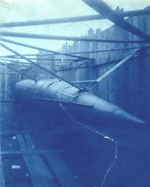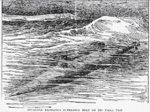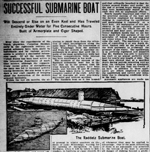| Click On Image For Full Size | Size | Image Description | Source | ||
|---|---|---|---|---|---|
 |
166k | The 65' long submarine designed by Richard Raddatz in dry dock along the Fox River in Oshkosh, 1897. In the summer of 1897, one of the first practical submarines in history was tested for the first time on the Fox River in Oshkosh. The submarine, invented by Richard Raddatz, made a brief trial run below the surface of the river in June of 1897 before a large crowd. The spectacle amazed those who watched it, convincing many that the local marvel would become a world-renowned innovational breakthrough. For several years around the turn of the 20th century, Oshkosh and its native son were at the forefront of maritime achievement. Raddatz’s submarine garnered international acclaim for its creator and its home. The notoriety would not last long, as the submarine slipped into obscurity in a matter of several years. The 1890s marked an era of progress for submarine technology. Underwater travel had long been a dream of engineers. Many believed mastering underwater travel to be a challenge equal to mastering air travel. Inventors tried to master underwater sailing as early as the 1600s. During the American Revolutionary War, David Bushnell created a submersible craft designed to destroy British ships in Boston Harbor. The Turtle was only capable of descending to the point at which only the small conning tower atop the vessel was visible above the surface, but not entirely under water. During the American Civil War, the Confederacy employed a more practical submarine. The H.L. Hunley managed to destroy a Union vessel in Charleston Harbor in 1864, but the sub was lost during that same mission. In fact, the H.L. Hunley sank three times during its career, killing three separate seven-man crews. Despite the limited success of submarines to that point, much interest and capital was given to developing a practical submarine following the Civil War. Richard Raddatz, son of Frederick and Louisa Raddatz of Utica, was one of many around the world who was fascinated by the prospect of submarine travel. Raddatz was a recent graduate of the State Normal School (now the University of Wisconsin Oshkosh) when he set out to create a submarine of his own. Raddatz, an engineer, drew up plans for his first submarine several years before 1897. His first design was made entirely of wood and was powered by a bicycle-like apparatus within the sub. Helping Raddatz build this ship was cooper August G. Schulz, of Oshkosh. Schulz, a German immigrant, was the proprietor of Oshkosh Cistern and Tank Co. (later Oshkosh Tank and Lumber Co.) on Seventh Street. His skill at producing watertight containers, and the resources at his disposal, made Schulz instrumental in Raddatz’s work. Raddatz’s first sub was constructed at Oshkosh Tank and Lumber Co. and parts for the subsequent subs were also built there. The wooden boat, measuring roughly 30 ft. long, was designed to submerge via two large fins along the side of the craft, which would work like the ailerons of an aircraft. The operator of the sub would simply turn the fins in a downward direction, which would direct the sub downward. The impractical diving mechanism and wooden hull made submerging the vessel nearly impossible. Raddatz scrapped the first sub and promptly began designing another one around 1894. Raddatz’s second sub was completed sometime between 1895 and 1896. This sub was constructed of 5/16 inch steel, employed a kerosene engine for surface travel, and had an electric motor for submerged travel. Raddatz also altered the diving mechanism of this sub. He designed a ballast system to control the sub’s diving. A ballast system uses a series if pumps to intake and discharge water to control the depth of the sub. The ballast system on the Raddatz sub was controlled by a foot pump made to inflate bicycle tires. This submarine was 35 feet long and 4 feet in diameter. The only places where a person could stand upright on the craft were in either of its two turrets. One was for the operator of the craft at the front; the other was for the operator’s assistant in the aft section of the sub. Both turrets were equipped with small glass ports for peering into the water. This sub made several successful dives, but was confined to do so in the boat house it was assembled in. Raddatz knew that the sub needed to be improved upon in several areas before it was ready to be truly tested. Instead of building an all new sub, Raddatz decided it to be more practical to improve his current sub to meet higher standards. Between 1895 and 1897, Raddatz worked to perfect his submarine. Most of 1895 and 1896 was spent trying to procure supplies and funding. During this time, Raddatz left the craft submerged in a boat house on the Fox River for safe-keeping and to hide it from the public eye. When work commenced on the sub, it was lifted to dry-dock and surrounded by a tall wooden fence for privacy. Raddatz and his crew of three extended the sub’s overall length to 65 feet. The boat was tapered to points starting 16 feet from the bow and stern. This spindle shape was designed to make underwater travel easier. New machinery was added to the sub, including an improved 30 cell storage battery for the electric motors. The engine within the sub was also upgraded with a 40 horsepower variant capable of spinning the two-blade propeller at a maximum speed of 1800 RPM. The completed submarine weighed in at roughly 31 tons. The most notable innovation to the sub was an air purification system of Raddatz’s invention. One of the biggest obstacles with prolonged submerged travel is maintaining a fresh air supply within the submarine. Raddatz, inspired by the work of other inventors, took advantage of a chemical reaction to create oxygen within the sub. The exact means of which Raddatz created his oxygen generating device were kept mostly confidential. Raddatz divulged that the oxygen was being created by “…absorbing carbonic acid gas in caustic potash, caustic soda and lime”. A similar method is used in modern carbon scrubbers. On June 21, 1897, the submarine was ready for its first trial run. This trial would test every aspect of the submarine’s design. Not only would the vessel submerge, but would then travel beneath the surface. The test called for the sub to submerge at a controlled rate to the bottom of the Fox River and remain motionless there for a brief time. Then the sub would briefly navigate the bottom of the river and surface, all within fifteen minutes. Raddatz would be accompanied by William and Otto Konrad, who funded much of the sub’s construction, as well as a reporter from the Oshkosh Daily Northwestern. After nearly a half hour under water, the crowd grew restless. Many wanted to call for a dredge to pull out the sub, which they believed had foundered, while others wanted to call the fire department. Before anyone could retrieve emergency assistance, the sub surfaced to an ovation from the crowd. The sub had traveled several miles upriver, which was farther than anyone had anticipated. Raddatz also went to the draw of the Chicago & Northwestern Railroad Bridge and descended to a depth of over 30 feet, which was believed to be a record depth at the time. Those aboard the sub were able to vouch for the quality of its performance. The vessel descended slowly and in a controlled manner, it did not bob or roll while under the surface, and it traveled at surprising speed. Accounts from inside the sub state that the sub moved effortlessly, and Raddatz appeared to have complete control of the sub’s every movement. Passengers also noted the abundant amount of fresh air within the sub. The trial was deemed an overwhelming success, and news of the achievement spread across the country. During the course of the next several months, Raddatz made many more voyages; he claimed to have made over 100 dives with the craft during the remainder of 1897, taking with him 65-70 passengers. The submarine was put into dry-dock at the end of the 1897 shipping season for winter storage. Raddatz’s sub would not be staying in Oshkosh long, though. In October of 1897, Raddatz sold his sub for an undisclosed price to a syndicate of two Milwaukee investors and several men from the East coast. The boat was moved by rail to Milwaukee in April of 1898. Richard Raddatz also went to Milwaukee to continue work with the sub. While in Milwaukee, the submarine underwent several more improvements before being tested again in the harbor of Milwaukee. One of the trials was performed in front of representatives from the U.S. War Department, as they were interested in the prospects a submarine presented. On this trial, as on many others, Raddatz spent nearly three hours underwater at depths ranging from just below the surface to as deep as 30 feet. Raddatz believed his sub could remain underwater for nearly 10 hours, reach speeds of 14 mph on the surface and 10 mph submerged, and dive to a maximum depth of 500 feet. In reality, the sub was never tested at a depth exceeding 50 feet and never remained underwater for much longer than three hours. Raddatz had planned to conduct deep water tests in Lake Michigan, but was barred from doing so by law. The submarine was classified as a war vessel by the Navy, which would make navigating the Great Lakes illegal according to a treaty the U.S. had signed with Great Britain following the War of 1812. Raddatz was forced to convince the U.S. Government that the boat was not a war vessel, but rather a vehicle for exploration. The conical spires at the end of the boat gave the impression that the boat was designed to ram other vessels in time of war. In fact, during the Spanish American War, there was talk that the Raddatz boat was to be sent to Havana Harbor to do just that. “The boat is not intended solely for waging war on the leviathans of the deep,” Raddatz said, “…although with its steel nose it can sink any battleship afloat with ease. I hope to see it put to useful and peaceful work.” Raddatz believed his sub could be used in the repairing or salvaging of ship wrecks, performing geodetic surveys, or harvesting resources from the sea. The results of the attempt to change the classification of the ship are unknown. The submarine was eventually dry-docked at Jones Island, in Milwaukee, for repairs and improvements in 1899. Two of the owners of the sub sold their respective shares out, and plans to improve the boat stalled as funding fell short. The fate of the submarine is unknown. It is believed that the sub was left on Jones Island for several years until it was scrapped. Another claim states that the sub was sold to J.P. Holland’s Electric Boat Company in 1900. Holland, who is considered the father of the modern submarine, launched his first practical submarine a month before Raddatz launched his. The Holland boat received much more national attention than Raddatz’s, due in large part to the fact that Holland’s boats were being built and tested in New York. J.P. Holland also had connections in the War Department and national news affiliates. These connections would eventually pay off for Holland, who was offered a contract to produce five submarines for the U.S. Government in 1900. Raddatz had developed an effective diving mechanism and an air purification system before Holland was able to do so. Similar innovations found their way onto Holland boats around 1900. Richard Raddatz remained in the Milwaukee area working as an engineer and designer for E.P. Allis and Allis Chalmers until at least 1921. In 1898, Raddatz married his wife, Anna, in Milwaukee. Together, the couple had two children: a son, Ronald, and a daughter, Anna. Ronald Raddatz moved to Missouri, dying there in 1980. Anna, Richard’s daughter, remained in Milwaukee until her death in 1989. August Schulz, the man who helped Raddatz build his early submarines, lived in Oshkosh until his death in 1933. |
Text & photo courtesy of oshkoshmuseum.org Researched, compiled and written by Adam Kohler for the oshkoshpubliclibrary.org, Nov. 2014. | ||
 |
123k | The 65' long submarine designed by Richard Raddatz in dry dock along the Fox River in Oshkosh, 1897. | Text & photo courtesy of oshkoshmuseum.org | ||
 |
4.24k | SUBMARINE BOAT MYSTERY LATEST PHOTOGRAPH OF THE WONDERFUL SUBMARINE BOAT |
Image and text provided by Minnesota Historical Society; Saint Paul, MN. Photo from The Saint Paul Globe. (St. Paul, Minn.) 1896-1905, 09 January 1898, Image 9, via chroniclingamerica.loc.gov. |
||
 |
1.28k | Invention of Richard Raddatz Swims and Dives Like a Duck | Image and text provided by University of Nebraska-Lincoln Libraries, Lincoln, NE. Photo from The Valentine Democrat(Valentine, Cherry Co., Neb.) 1896-1898, 13 January 1898, Image 3, via chroniclingamerica.loc.gov. |
||
 |
1.37k | SUCCESSFUL SUBMARINE BOAT Will Descend or Arise on Even Keel..... |
Image and text provided by Montana Historical Society; Helena, MT. Photo from The Anaconda Standard. (Anaconda, Mont.) 1889-1970, 03 April 1898, Morning, Image 22, via chroniclingamerica.loc.gov. |
||
 |
3.43k | ONCE A GLORY, BUT NOW RUSTING IN SECLUSION | Image and text provided by Washington State Library; Olympia, WA. Photo from The Seattle Star. (Seattle, Wash.) 1899-1947, 04 May 1903, Image 1, via chroniclingamerica.loc.gov. |
||
Crew Contact And Reunion Information
Not Applicable to this Vessel
Additional Resources and Web Sites of Interest
ANOTHER SUBMARINE BOAT.; Apparently Successful Trial of the Raddatz Craft at Milwaukee.
A SUBMARINE BOAT
ANOTHER SUBMARINE CRAFT
RADDATZ'S SUBMARINE BOAT.; A Sale Reported and a Successful Test Made.
Raddatz Submarine Boat Sold.
| Back To The Main Photo Index | Back To the Submarine Index |
| Problems and site related matters, E-mail Webmaster |
| This page is created and maintained by Michael Mohl All Pages All Pages © 1996 - 2025 NavSource History. All rights reserved. |